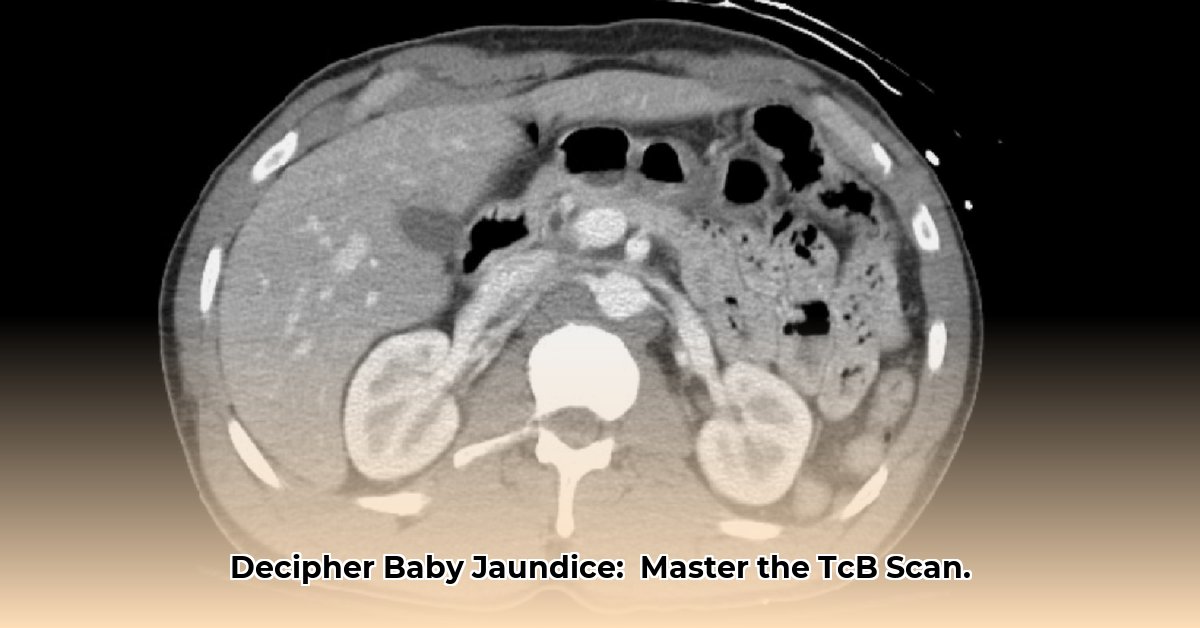Want to improve your TcB scan interpretation skills for newborn jaundice screening? This guide provides actionable steps to enhance accuracy, minimize missed cases, and stay current with best practices. Designed for healthcare professionals, this article helps you leverage TcB technology for effective jaundice management and minimize complications associated with hyperbilirubinemia. For further guidelines on TcB scans, see these helpful resources.
TcB Scan Clinical Interpretation: Mastering Neonatal Jaundice Screening for Early Detection
Transcutaneous bilirubin (TcB) scans offer a non-invasive method for assessing neonatal jaundice, but accurate interpretation is crucial for timely intervention. While clinical guidelines provide a foundation, they may not always account for variations in skin color, gestational age, or device types. This section explores how to refine your TcB scan clinical interpretation for optimal results, ensuring every newborn receives the appropriate care.
The TcB Accuracy Challenge: Expert Opinions and the Need for Precise Jaundice Assessment
Although TcB scans are widely accepted for initial jaundice screening, determining the precise bilirubin level requiring further blood tests (total serum bilirubin – TSB) remains a topic of debate among neonatologists. TcB measurements estimate bilirubin levels through the skin, offering a less invasive approach compared to blood draws. While TcB scans reduce unnecessary blood draws and associated discomfort for newborns, a universally applicable threshold for phototherapy initiation isn’t available due to device variations and skin tone differences. Interpretations must be personalized, taking into account these variables, to adhere to best practices. Implementing standardized protocols and regular training for healthcare providers can further enhance accuracy.
Enhancing TcB Scan Effectiveness: Practical Guidance for Accurate Neonatal Jaundice Measurement
Maximizing the utility of TcB scans requires a meticulous and comprehensive approach. Consider the following:
-
Device Selection and Calibration: Choose TcB measurement devices carefully, prioritizing those validated for diverse populations and ensuring proper calibration according to manufacturer guidelines. Comprehensive staff training on device operation and maintenance is equally important. Regular equipment accuracy checks using quality control standards are essential for precise readings and consistent results over time.
-
Holistic Assessment Beyond Numbers: While TcB values provide important data, consider the baby’s gestational age, birth weight, and overall health status during assessment. Small details greatly impact interpretation. For example, preterm infants may require different intervention thresholds than full-term babies.
-
Continuous Professional Development: Stay informed about the latest advancements in neonatal jaundice management, including new guidelines, research findings, and technological developments. Regularly evaluate your interpretation process and assess how new guidelines can improve accuracy and effectiveness. Participation in workshops and conferences can also facilitate knowledge exchange and skill enhancement.
-
Understanding Limitations due to Haemolysis Use caution where there is known or suspected haemolysis (e.g. where there are maternal blood group antibodies of concern, a history of siblings with severe early haemolysis or the baby is DAT positive in keeping with haemolysis). In this group it may be prudent to use serum bilirubin measurements, at least initially. Any baby falling into this group (known or suspected haemolysis) should have their initial management in a hospital setting and a clear plan for follow up sampling etc made by the discharging paediatrician.
-
Embracing Technological Innovation with AI: Monitor the evolving role of artificial intelligence (AI) in jaundice management. AI-powered algorithms show potential for more accurate predictions of treatment necessity and optimize screening.
Future Directions in TcB Scan Application: Research, Advances and Regulatory Standards
Improving TcB scan reliability requires technological advancements and continued research focused on addressing existing limitations. Larger comparative studies, improved methods for accounting for individual patient differences (skin color, gestational age, health status), and standardization of measurement techniques are vital. Regulatory bodies, like the FDA, can play a crucial role in establishing higher accuracy standards for TcB machines and approving new technologies that offer improved performance.
Improved technology, comprehensive training, and sound clinical judgment are crucial for optimal care and reduced rates of hyperbilirubinemia-related complications. Collaboration between researchers, clinicians, and regulatory agencies will accelerate progress in this field.
Comparing Screening Methods: A Decision-Making Matrix for Jaundice Detection
This table outlines common screening approaches, emphasizing the importance of preventing missed jaundice cases and potential downsides of each method.
| Method | False Negative Risk (Missing Jaundice Cases) | Risk of Unnecessary Blood Tests | Cost | Complexity of Use |
|---|---|---|---|---|
| TcB (above threshold) | Moderate | Low | Low | Relatively simple |
| TcB (compared to phototherapy) | Moderate | Low | Low | Relatively simple |
| TcB (fixed range) | Low to Moderate | High | Low | Relatively simple |
| TSB (blood test) | Low | High | Moderate | Simple |
| AI-enhanced TcB | Low | Low | Moderate | More technically complex |
The decision regarding the most appropriate screening method should prioritize minimizing potential complications associated with both missed cases of jaundice and unnecessary interventions. Balancing the prevention of missed cases and avoiding unnecessary procedures is essential. Ongoing research and technological advancements will refine assessments and comparative evaluations, leading to more efficient and effective strategies.
Enhancing TcB Decision Rules for Neonatal Jaundice Screening for False Negative Reduction
Key Takeaways:
- TcB offers a non-invasive alternative for neonatal jaundice assessment, reducing the need for invasive blood draws.
- TcB accuracy varies by gestational age, ethnicity, and other factors, making tailored decision rules crucial for effective application.
- Minimizing false negatives requires adjusting algorithms to account for variations in skin pigmentation and other influencing factors.
- Further research is needed to improve TcB effectiveness and develop universally applicable decision rules.
Understanding TcB Screening Challenges for Accurate Jaundice Diagnosis
Detecting neonatal jaundice accurately is critical, as untreated hyperbilirubinemia can lead to severe neurological complications, including kernicterus. TcB provides a convenient and less invasive screening method, but its accuracy isn’t flawless, and relying solely on TcB readings can lead to missed cases and delayed treatment. Several variables affect TcB readings, potentially leading to false-negative results, particularly in infants with darker skin pigmentation. Addressing these challenges is essential to optimize TcB decision rules for neonatal jaundice screening minimizing false negatives and ensuring equitable care for all newborns.
Factors and Risks Affecting TcB Accuracy in Screening and Interpretation
Several factors influence TcB measurements, including skin pigmentation, gestational age, and postnatal age. Skin pigmentation, particularly the concentration of melanin, can affect the way light is absorbed and reflected, impacting TcB readings. Device calibration, measurement site (sternum vs. forehead), and ambient light also play roles. Inconsistent techniques among healthcare professionals introduce variability.
Strategies for Optimizing TcB Decision Rules and Newborn Screening Protocols
How to optimize TcB decision rules for neonatal jaundice screening minimizing false negatives requires a multi-faceted approach that addresses the inherent limitations of the technology and accounts for individual patient characteristics:
- Gestational Age Adjustment: Correct TcB readings based on gestational age, particularly for preterm infants, to reduce false negatives. Preterm infants often have thinner skin and different bilirubin dynamics compared to full-term infants, necessitating tailored interpretation.
- Standardized Protocols: Implement and adhere to standardized TcB measurement protocols, including training, calibration, and ambient light control. Standardized protocols minimize variability and ensure consistent readings across different healthcare providers and settings.
- Validation and Refinement: Regularly validate TcB readings against serum bilirubin levels to refine decision rules and identify potential sources of error. Continuous monitoring of TcB performance helps maintain accuracy and reliability over time.
- Risk Assessment: Incorporate ethnicity, maternal history, and feeding patterns into assessments to enhance TcB screening sensitivity. Identifying risk factors for hyperbilirubinemia allows for more targeted screening and intervention.
- Multi-Center Studies: Conduct large, multi-center, randomized controlled trials to compare TcB performance with traditional methods for optimized recommendations that are generalizable across diverse populations. Collaboration among healthcare institutions promotes knowledge sharing and standardization of best practices.
Implementing Optimized TcB Protocols for Improved Neonatal Jaundice Management
Effective implementation requires collaboration among healthcare providers, hospitals, and policymakers. Healthcare providers need comprehensive training and ongoing support to implement and adhere to optimized TcB protocols. Hospitals need to establish standardized procedures and invest in appropriate equipment. Policymakers should fund research to further refine TcB technology and decision rules. This ensures widespread adoption, reduces costs, and improves newborn care.
Optimizing TcB Meter Selection for Diverse Neonatal Populations for Best Results
Key Takeaways:
- TcB measurement offers a non-invasive alternative to TSB tests, reducing the need for painful and stressful blood draws for newborns.
- Decision rules for interpreting TcB readings vary, impacting effectiveness across different populations, particularly those with diverse skin pigmentation.
- Optimizing TcB meter selection is crucial for ensuring accurate and reliable jaundice screening in diverse populations.
- Technological advancements promise improved accuracy and reduced variability, but require careful evaluation and validation.
- Integrating TcB data into electronic health records (EHRs) and clinical decision support systems (CDSS) is essential for streamlined workflows and informed decision-making.
Understanding TcB Meter Technology for Accurate Jaundice Readings
Accurate neonatal jaundice diagnosis is critical for preventing potential complications such as kernicterus. Traditional serum bilirubin (
- Vertical Axis Wind Turbine Design: Improving Efficiency and Overcoming Limits - October 29, 2025
- Wind Turbine to Power Home: Nacelle Design Improvements Advance - October 26, 2025
- Wind Turbine Blade Length: How Long Is Too Long? - October 24, 2025
















